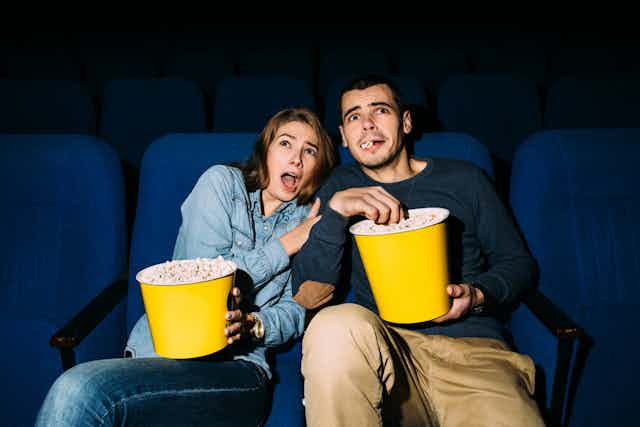On Halloween we celebrate the things which scare and amuse in equal measure. We don playful costumes and decorate our homes with plastic vampires, ghouls, and other representations of the things that go bump in the night. The sounds of laughter mix with shrieks as we seek out the humour in the darker side of our culture.
Although horror and comedy may seem like opposing genres, many of the horror films that we revisit at this time of year have comedic elements – whether planned or not – among the scares. Consider The Exorcist (1973), in which a literal fountain of pea soup (mixed with Oatmeal) spews from the possessed child Regan’s mouth. The scene is one of the most parodied of all time. It is extremely shocking, yet equally surreal and over the top.
Films which actually blend comedy and horror have become a staple of the horror cannon too. Rather than having perhaps unintentional laughs among the scenes, these films are a direct humorous take on horror tropes. Take John Landis’ An American Werewolf in London (1981), for example. In just one of the many comedic scenes, the werewolf (in human form) is berated by a cinema full of undead victims – unhappy that he ripped them limb from limb and “helpfully” suggesting ways in which he might approach his own suicide.
Equally, films such as rom-zom-com Shaun of the Dead (2004), undead parody sequel Evil Dead II (1987) and Abbott and Costello Meet Frankenstein (1948) – where the comedy duo meet several noted horror characters, such as Frankenstein and Dracula – have also proved that far from being opposing genres, comedy and horror often make successful cinematic bedfellows.
Juxtaposed or meant to be?
According to film theorist Jule Selbo, exaggeration and absurdity are key elements in the construction of a comedy film, while being excessive is vital to the creation of horror productions. Comedy and horror are linked through their willingness to go over the top.
One of the best known genre-blending masters of the last few decades is director Quentin Tarantino, who interestingly cited Abbott & Costello Meet Frankenstein as one of the top three most influential films on his career. Watch the notorious ear cutting scene in Reservoir Dogs (1992), for example, and you will see Tarantino’s absurd blending of comedy and horror. Many cinema-goers had to look away from the screen as Michael Madsen’s deranged gangster Mr Blonde tortured a captured policeman, while simultaneously dancing to Stuck in the Middle With You by Stealers Wheel.
So why do these genres work so well together? First, both comedy and horror films frequently transgress the norm to tell their stories. The very reason for these films is to place characters in absurd and extreme situations. This is a construct which mainly speaks for itself in the horror genre, as it often centres on the paranormal, deviant or fantastical, but it is often also prevalent in comedy cinema. How many stag parties have you attended which resulted in one of the stags being punched by Mike Tyson, who has discovered you harbouring his stolen pet tiger in your hotel bathroom? And that mask you found at the harbour on the weekend, did it turn you into a fast-talking, green-faced cartoonish superhero when you tried it on?
In addition, filmmakers who work across genres, like Tarantino, are willing to provoke outrage through excess that Selbo suggests is so vital. The Django Unchained director in particular is well known for his outrageous use of blood effects.
Horror is a notoriously excessive genre, and increasingly the battle for attention in a crowded marketplace has led to filmmakers pushing elements of excess and controversy. Films such as The Human Centipede and its sequels go far beyond where many other filmmakers dare – though any laughs to be had when watching this particular title are mainly illicit and come from discomfort.
Meanwhile, comedy genre filmmakers such as Sacha Baron Cohen – who created controversial characters Borat and Bruno – and the Farrelly Brothers (Kingpin (1996), There’s Something About Mary (1998)) have also pushed the boundaries in comedy. The notorious hair gel scene in There’s Something About Mary is one famous example, as is the extreme close-up naked male wrestling in Borat. Both scenes have audiences hiding their eyes as much as laughing at the excess and absurdity onscreen.
So, on the surface it may seem that horror and comedy are opposing genres. One genre is designed to scare and horrify audiences, and the other to amuse and make audiences laugh. But through absurdity and excess – and a brazen willingness by filmmakers to go over the top – the two genres are more closely linked than you may imagine. This Halloween we may be shrieking with laughter as much as fright.

